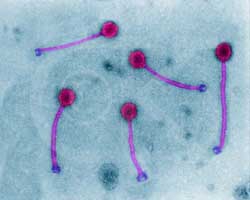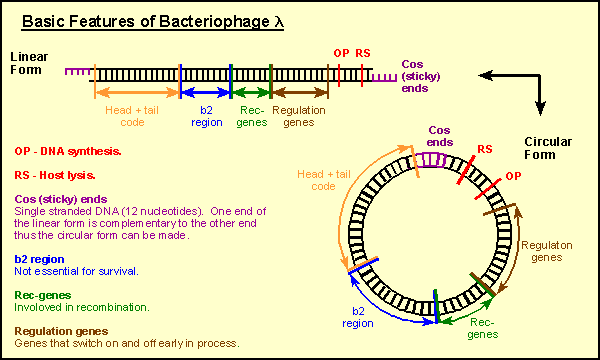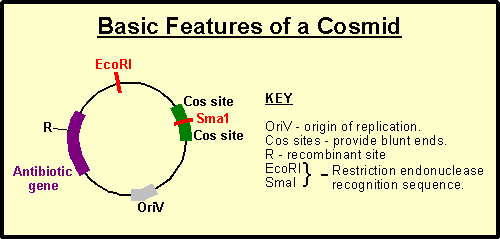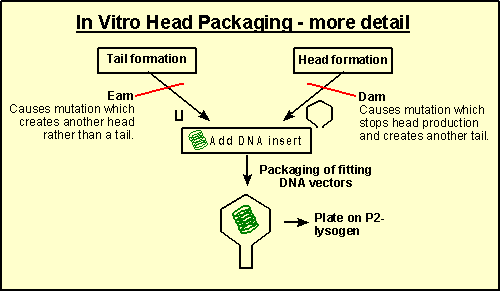
This page was produced as an assignment for an undergraduate course at Davidson College
Bacteriophages

figure1: photograph of bacteriophages, permission pending from Dennis Kunkel
WHAT ARE THEY?
Bacteriophages are viruses that infect bacteria.
WHAT IS THE big DEAL?
The bacteriophage lambda is important in molecular biology because it is used in constructing vectors for gene cloning. Plasmids do this as well, but bacteriophages have an advantage over plasmids. Plasmids are circular, indpendently replicating, double-stranded DNA, most often found in bacteria. They replicate quickly and are easily manipulated in the laboratory. Plasmids are typically 2-10 thousand base pairs in size (Corbley, 1999). While this small size allows plasmids the two aforementioned attributes, it aslo means that plasmids are limited in the DNA fragments they can clone. They are typically limited to fragments around 5 thousand base pairs (King, 2002). While plasmids are great vector vehicles for many molecular endeavors, if the fragment to be cloned is larger than the available insertion space of the plasmid, the plasmid vector will probably not transfer the fragment of DNA successfully.

figure 1: Bacteriaphage lambda contains double stranded DNA and includes cohesive ends, important in the construction of cosmids
BACTERIOPHAGES become COSMIDS
Bacteriophage lambda serves as a molecular tool in several ways. It can be used in conjunction with plasmids when both plasmid and phage are cut by a restriction enzyme. The cut segment of the phage DNA is inserted into the double strandad plasmid which replicates in E.Coli. The points at which the segment of bacteriophage lambda is cut are called cos (cohesive) sites. The resulting vector is called a cosmid. It is a hybrid vector, part phage, part bacteria, that can be used to clone larger genes or fragments of DNA. More DNA can be cloned in a cosmid than in a plasmid because the cohesive sites of the cosmid allow the lambda packaging system to inset more DNA into lambda heads. The loading capacity of cosmids is usually 40-45 thousand base pairs.
Cohesive sites get their name from the tendency of ends to bind (base pair) with eachother. The cos sites are the only part of lambda that is included in the plasmid for a cosmid vector. No viral genes are included in the vector when the plasmids are introduced to E coli, so the construct replicates as plasmids. The amplified DNA may be isolated from the infected cells. The cosmid vector not only transfers larger pieces of DNA to E. Coli cells, but it also infects these cells more efficiently than regular plasmid (Sofer, 1999). Both cosmid and plasmid tramsformations are detected by selecting antibiotic-resistance colonies which indicate the DNA was inserted at an antibiotic resistance site.

figure 3: The basic procedure of cosmid production includes the following: (Drexel University, 2001)
IN VITRO PACKAGING
Bacteriophages are useful, not only as cosmids. The viruses themselves can be cut and inserted into. These constructs are called insertion vectors and differ from plasmids because they are detected by phage plaques in a bacterial lawn rather than antibiotic-resistance colonies (Dale, 1989). The uptake in cells is also different for bacteriophage lambda and plasmids. Lambda undergoes its lytic cycle and phage heads are produced within the bacterial cell it entered. Cos sites determine where specific cuts are made in the DNA sequence. This can be accomplished in vitro when DNA, appropriate enzymes, and cell extracts containing heads and tails are combined. This process is called in vitro packaging. It takes advantage of viruses' natural ability to infect cells by creating infectious virus constructs capable of injecting DNA into a sensitive host cell (Purves, 2001).

figure 4: in vitro packaging places DNA lengths cut from a DNA molecule in phage heads.
Packaging limits of lambda particles are procured because the size of the inserted DNA must fall between 78% and 105% of the wild-type phage DNA. If the distance between cos sites is too small or too large, the resultant phages will not be viable (Sofer, 1999). The distance between the cos sites can be lengthened by inserting a segment of non-phage passenger DNA (Sofer, 1999).

figure 5: Lambda is cloned either via an insert of DNA between cos sites (a) or an insert of DNA between cos sites where a "stuffer fragment" has been removed (b). (fig.10-2, pg. 178, Molecular Genetics of Bacteria).
This is a general description of the form and function of bacteriophages and how they are used in molecular research. They are used both with and in place of plasmids. They are pseudo-similar in style to bacterial artificial chromosomes ( BACs ) and yeast artificial chromosomes (YACs.)
References:
Brune W, Messerle M, Koszinowski UH, Pettenkofer M, Haber JE. 2000. Forward with BACs: new tools for herpesvirus genomics. TIG <http://download.bmn.com/pdf/journals/atoz/browse?uid=TIG.etd00340_01689525_ 0016i06_00002015& rendertype=pdf&ft l_accessed_via=BROWSE&node=TOC%40%40TIG%40019%4002%40019_02&mis=.pdf>. Accessed 2003 Feb 17.
Cosmid Vectors. Homepage. <http://www.brunel.ac.uk/depts/bl/project/genome/moltec/library/cosvec.htm> Accessed 2003 Feb 15.
Corbley MJ, 1999.Plasmids <http://home.earthlink.net/~corbley> Accessed 2003 Feb 15.
Dale, Jeremy W, Molecular Genetic of Bacteria. 1989. New York: John Wiley & Sons. pp.178-179.
Drexel University, 2002 . Homepage. <http://www.drexel.edu/academics/coe/ce/web_books/EngBio/Hidden/molec/tocmolf.htmf> Accessed 2003 Feb 15.
King MW, 2002. Molecular Tools of Medicine <http://www.indstate.edu/thcme/mwking/molecular-medicine.html>. Accessed 2003 Feb 16.
Lin ECC, Goldstein R, Syvanen M. Bacteria, Plasmids, and Phages: An Introduction to Molecular Biology.1984. London: Harvard University Press.
Purves WK, David S, Orians GH, Heller HC Life: The Science of Biology 6th ed. 2001. Gordonsville, Virginia: Sinauer Associates, Inc. p. 315.
Sofer W, 1999. Genetic Engineering <http://gregor.rutgers.edu/genetics/Week15/Lecture15-2.html> Accessed 2003 Feb 16.
Davidson College Molecular Biology Home Page
Send Questions/Comments to Emily Wilson